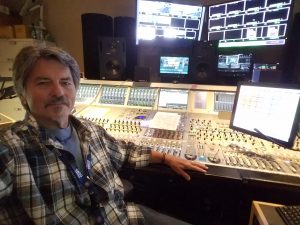College Football Kickoff: Raycom’s ACC Football Package Brings Big-League Audio to RSN Coverage
Veteran A1 Jim Budka is deploying lots of mics, decades’ worth of experience
Story Highlights
In his prime, Jim Budka was Turner Sports’ go-to A1 for most of its major-league–sports broadcasts. Officially retiring in 2014, he spent much of the next couple of years happily driving the trolley that takes tourists around his current hometown of St. Augustine, FL, with occasional fill-in stints as an A1 or A2 for CBS and Turner on MLB and NBA games. More recently, though, Budka has found an opportunity to apply decades’ worth of national-network broadcast-audio skills to the burgeoning RSN landscape. Specifically, he’s now the A1 in charge of sound for Midsouth Regional Emmy Award-winning Raycom Sports’ ACC football package, which hits the air on Sept. 1.
“It’s sports on television the way it used to be,” he says, recalling that broadcast sports audio was often compelling a couple of decades ago, before 5.1 surround and hundreds of microphone inputs became the norm and when object-based audio would have been more science fiction than science.

A1 Jim Budka: “Making sports on television exciting is still a matter of technique as much as technology.”
For Raycom’s ACC package, mostly Saturday-afternoon games broadcast on one of Fox’s regional sports networks, such as FS1 or Fox Sports South, and the YES Network in New York, Budka will be working with a few dynamic crowd mics, two or three camera-mounted microphones, a pair of hard-wired parab mics, a couple of microphones to capture the college bands, one wireless reporter (Rebecca Kaple) with a handheld wireless mic, and headsets for the announcers, Wes Durham and James Bates.
“It’s not much compared to what we’d use for NFL games, but you’d be surprised how full the sound is if you mix it correctly,” he says, by which he usually means mixing it fairly loudly. “For instance, I really pump the bands going into and out of the breaks, because it gives the viewers a real sense of being right there in the stadium; the bands kind of define college football. And I tend to put a lot of high end into the parabs, which gives me a crisper-sounding line of contact when the [players’] pads slap.
“[Director Lonnie] Dale doesn’t give me much in the way of direction, and he and [producer] Dave [Barringer] pretty much give me free rein when it comes to the audio,” he continues. “Master control tries to tell me to pull the levels back some, but, a few games into the season, they realize that this is the kind of mix I’m doing, and it’s working.”
Budka is working out of Raycom’s Phoenix remote-production truck; doubleheaders will also pull in Token Creek’s Chippewa, which houses a Calrec Artemis console, Pesa router, and RTS intercom.
Although the technology complement is light compared with what the major networks deploy for college games, Budka says, it is combined with a wealth of experience — he has worked on the Super Bowl and other events and occasional A1 work for the NFL Jaguars; Durham headed up Georgia Tech’s broadcast department and did radio for the Atlanta Falcons; Bates was a University of Florida linebacker; and Kaple hosts studio shows for Braves LIVE on Fox Sports South and Fox Sports Southeast — making the ACC shows more than competitive with SEC broadcasts.
“Making sports on television exciting is still a matter of technique as much as technology,” says Budka. “Expertise matters, and sometimes what lots of microphones do is just overkill. It’s amazing what you can do with a few microphones if you know what do with them.”
